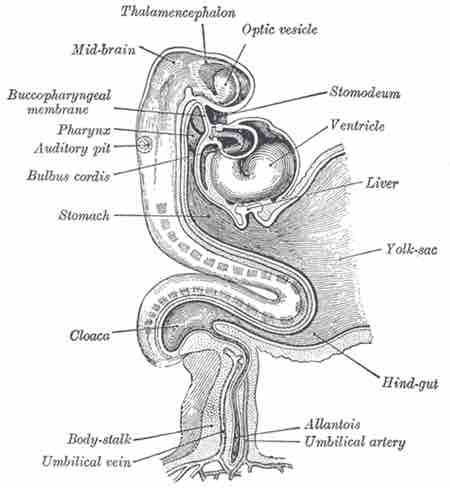The gut is an endoderm-derived structure. At approximately the 16th day of human development, the embryo begins to fold ventrally (with the embryo's ventral surface becoming concave) in two directions: the sides of the embryo fold in on each other and the head and tail fold toward one another. The result is that a piece of the yolk sac, an endoderm-lined structure in contact with the ventral aspect of the embryo, begins to be pinched off to become the primitive gut . The yolk sac remains connected to the gut tube via the vitelline duct. Usually this structure regresses during development. In cases where it does not, it is known as Meckel's diverticulum.

Development of Digestive System
Sagittal section of embryo at about four weeks showing the primitive gut.
During fetal life, the primitive gut can be divided into three segments: foregut, midgut, and hindgut. Although these terms are often used in reference to segments of the primitive gut, they are also used regularly to describe components of the definitive gut as well. Each segment of the gut gives rise to specific gut and gut-related structures in later development. Components derived from the gut proper, including the stomach and colon, develop as swellings or dilatations of the primitive gut. In contrast, gut-related derivatives (that is, those structures that derive from the primitive gut, but are not part of the gut proper), generally develop as out-pouchings of the primitive gut. The blood vessels supplying these structures remain constant throughout development. The foregutis the esophagus to first two sections of the duodenum, liver, gallbladder, and superior portion of pancreas. The midgut is the lower duodenum, to the first two-thirds of the transverse colon lower duodenum, jejunum, ileum, cecum, appendix, ascending colon, and first two-thirds of the transverse colon. The hindgut is the last third of the transverse colon, descending colon, rectum, and upper part of the anal canal.